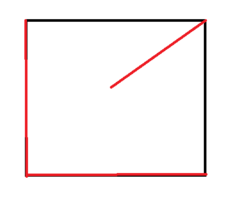Please help with my homework.
The neighbor's electricity cable runs straight through our square plot of land with the sides of 1. We would like to find the cable
and connect to it, but unfortunately we don't know where exactly this cable goes. Find a way to dig up
the garden so that we are guaranteed to find the cable for all configurations.
In the lecture, we showed that if we dig all sides of the square, the length of the excavation will be 4.
Furthermore, we figured, that there is no need to dig up all 4 sides, but to dig up only three sides and thereby obtain
solution of 3. The variant with digging both diagonals of the plot had a solution of 2√2. Your job is to find it
solution of Don't forget to show the procedure for calculating the exact way to dig.
Don't forget to show the procedure for calculating the exact way to dig.
Thank you.
The neighbor's electricity cable runs straight through our square plot of land with the sides of 1. We would like to find the cable
and connect to it, but unfortunately we don't know where exactly this cable goes. Find a way to dig up
the garden so that we are guaranteed to find the cable for all configurations.
In the lecture, we showed that if we dig all sides of the square, the length of the excavation will be 4.
Furthermore, we figured, that there is no need to dig up all 4 sides, but to dig up only three sides and thereby obtain
solution of 3. The variant with digging both diagonals of the plot had a solution of 2√2. Your job is to find it
solution of
Thank you.


